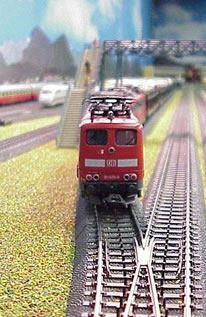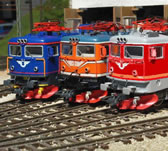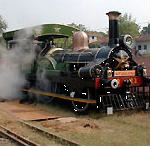Cover
All Aboard!
Start With The Basics
Why The Track Is So Important
How Does The Power Supply Work?
Analog
and DCC Explained
Layout Options Explained
Locomotives And Rolling Stock
What Should You Start With?
How Do You Create A Good Layout
More On Layouts and LDE
How to Create Realistic Scenery
Explain Weathering Techniques
How To Repair Problems
BONUS SECTIONS
Frequently Asked Questions
Glossary of Important Terms
Model Railroad Yard Design Explained Step-By-Step
Model Train Layout Track Plans
Garden Railroads
Mastering An Airbrush Step-By-Step
More
Model Railroad Resources
The
hands-on world of a model railroader is indeed a special experience. Bring
your sense of wonder with you… as this ebook takes you on a fascinating
journey… where you’ll learn everything you need to know to make and operate
a model railroad.
"We don't stop playing because we grow old,
we grow old because
we stop playing"
George Bernard Shaw
| Interesting
Fact: U.S. Railroads used steam locomotives from their inception in the early 1800s until the 1960s, when improvements in diesel power made diesel-electric powered rail locomotives a more cost-effective choice. Steam locomotives worked hard and easily produced enough tractive power to grip metal rail tracks, and pull heavy loads. But, over time, steam powered locomotives presented a difficult problem for the railroads. The production, maintenance and upkeep of steam locomotives were very specialized and became increasingly expensive for the railroads. By the late 1940s and early 1950s, it was no longer cost-effective for large U.S. railroad companies to maintain and run these powerful iron horses. |
It doesn't seem to matter whether you’re 5 or 95... or somewhere in between. The personal satisfaction of building and operating a realistic miniature layout is rewarding and fun… no matter what age you are. Model railroading is a truly rewarding leisure activity that will keep you busy and entertained for hours… if not a lifetime.
Freedom To Create Your Own World
Model railroading is an absorbing leisure-time activity that provides plenty of creative opportunities and interesting projects of a technical nature. It incorporates a variety of interesting activities from building, maintaining, upgrading and operating a train set. What kind of world you create, where you create it, and how much time you spend in it…. is entirely over to you.
You can build a layout in the solitude of your basement, attic, shed or garage workshop…or you can sit in a sun lounger and watch trains weave around your garden… or you can join a local model-railroading club and share your ideas and experiences with others. The opportunities are endless!
-
You’ll pickup valuable skills in: artistic painting, construction and carpentry, electrical wiring, problem solving and design.
-
You'll discover creative opportunities that will bring to the fore your hidden talents when building scenery.
-
You'll develop a in-depth knowledge of geography when designing and making landscapes.
-
You'll step back in time and learn how things operated in bygone days.
-
You'll gain some engineering skills when designing your layout to make it fit, build your bench-work so it won’t fall apart, or examine how a level crossing operates, or a bridge is built, or how to create an efficient shunting yard.
-
You'll enjoy the challenge of constructing realistic miniature replicas of life and scenes from history.
| Patience
And Knowing What You Want You don’t have to be a millionaire, or a technical genius, or a brilliant artist to be part of this world. The single most important skill you will require is patience. If you have plenty of patience, then you will thrive in this environment. The
scale you choose to model in will depend on what you want from a
layout and the space you have available. You may want to see long
trains running quickly through a town or countryside scene, or perhaps
you would prefer a small compact layout featuring a branch line
terminus and small goods yard with lots of small shunting moves.
|
 |
Interesting Fact: Model Railroading has been called "The Worlds Greatest Hobby", and rightly so. But, could it be a descendant of "The Worlds Oldest Hobby"? About 500BC the emperor of the Q'in (pronounced 'Chin' which is where the name China came from) dynasty wanted to view all the different regions of his empire. But of course it was impossible for him to be in all the regions of his empire at once. So he commissioned some artists in his empire to visit each region and make models of each region, so that he could view them all from inside his palace in the forbidden city. Once each diorama was completed, it was placed on a map of the empire that was carved into the floor in part of his palace. Each day he would travel through his whole empire, admiring the beauty of his kingdom. The dioramas were called 'penjing'. China in 500BC didn't have the benefit of Woodland Scenic's scatter and trees, or similar materials, and so the dioramas were made from real dirt and rocks, and small trees that were alive. The art of Bonsai owes it's existence to these penjings, and it would seem that maybe the 'art' of Model Railroading does too! |
What's Included In This Ebook?
It doesn't
matter whether you’re an experienced model railroader or a newbie, this
ebook will provide you with helpful information and useful ideas to help
you get the most from this enthralling hobby. We have by no means covered
every aspect in detail, but we have answered lots of the problems that
you will encounter along the way. We have done extra research for you
by sorting through websites and including valuable links to sites that
offer an enormous amount of genuine information.
Return to top of page
We won't try and impress you with loads of confusing technical jargon. We will keep it easy to read and clarify confusing terminology and technical terms. We'll help guide you with equipment choices, layouts and maintenance.
The important thing to note is that this book is independently written. We are NOT owned by any model train manufacturers or hobby companies, so we won't be trying to sell or push any particular brands. If we suggest something, it will be because we genuinely believe that is the best choice.
Interesting
Fact: The
Fairy Queen broad gauge steam locomotive was built in 1855 by
Kitson, Thompson & Hewitson, of England for the British firm
East India Railways. The petite engine worked from Howrah to Ranigunj
(121 miles). After a complete overhaul in Perambur Workshop of
the Southern Railway, it panted back to life in 1997.
|
The Fairy Queen made several trips between New Delhi and Alwar, India (89km of railway track) between 1997 and 1998. It now runs as a tourist train. |
Understanding The Technical Terms
Model railroading enthusiasts use plenty of fascinating technical terms. But, don't get “hung-up”on them. The important thing is to take things one step at a time and learn new terms and techniques as and when you are ready. Before getting started, we'll quickly outline some of the basic details and concepts to help you on your way. The definitions for some of the more important terms are included in the glossary at the end of the book, while others will be explained as we progress through this book.
What's
The Difference Between Toy And Model Trains? All trains might be referred to as being toys, but not all trains are considered to be models. That's the important difference. Model trains are designed exactly as the name implies, that they are scale renditions of real full size (prototype) trains. Model trains have dimensions that closely replicate the originals or real thing. Toy trains are made without this same attention to detail and accuracy. |
 |
Is Model Railroading Expensive?
Yes it can be, but so too is smoking, drinking, golfing, fishing, driving and most other things in life. Model railroading is an excellent hobby and can be as expensive, or as inexpensive, as you want to make it. If you want the full enjoyment of this enthralling hobby over many years, then be prepared to fork out a lot of money. If model railroading gives you a lot of pleasure and satisfaction, then it is well worth it.
However, what you invest is entirely over to you. If you're looking for something simple, then you can stick with a cheaper brand. It’s basically up to you. Just make sure that you know what you want and price out any purchase carefully.
Return
to top of page
© 2006 Robert
Anderson, Market Leaders Ebooks, all
rights reserved
